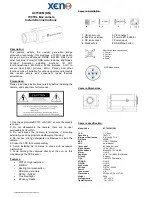
VIVOTEK
User's Manual - 69
If the power line frequency is set to 50Hz, the frame rates are selectable at 1fps, 2fps,
3fps, 5fps, 8fps, 10fps, 15fps, 20fps, and 25fps. If the power line frequency is set to
60Hz, the frame rates are selectable at 1fps, 2fps, 3fps, 5fps, 8fps, 10fps, 15fps, 20fps,
25fps, and 30fps. You can also select
Customize
and manually enter a value.
The frame rate will decrease if you select a higher resolution.
■ Intra frame period
Determine how often for firmware to plant an I frame. The shorter the duration, the
more likely you will get better video quality, but at the cost of higher network bandwidth
consumption. Select the intra frame period from the following durations: 1/4 second, 1/2
second, 1 second, 2 seconds, 3 seconds, and 4 seconds.
■ Dynamic Intra frame period
High quality motion codecs, such as H.265, utilize the redundancies between video frames to
deliver video streams at a balance of quality and bit rate.
The encoding parameters are summarized and illustrated below. The
I-frames
are completely
self-referential and they are largest in size. The
P-frames
are predicted frames. The encoder
refers to the previous I- or P-frames for redundant image information.
P I P P P P P P P I P P P P P P P I
By dynamically prolonging the intervals for I-frames insertion to up to 10 seconds, the bit rates
required for streaming a video can be tremendously reduced. When streaming a video of a
static scene, the Dynamic Intra frame feature can save up to 53% of bandwidth. The amount of
bandwidth thus saved is also determined by the activities in the field of view. If activities occur
in the scene, firmware automatically shortens the I-frame insertion intervals in order to maintain
image quality. In the low light or night conditions, the sizes of P-frames tend to be enlarged due
to the noises, and hence the bandwidth saving effect is also reduced.
H.264/265 Frame Types
■
Smart stream II
















































